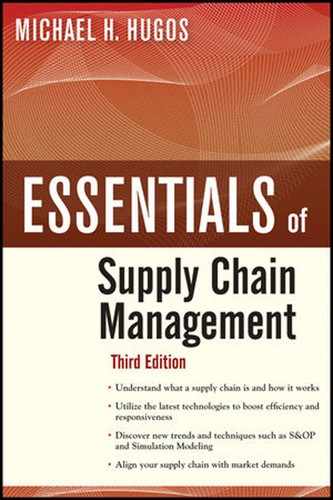CHAPTER 7
Supply Chain Innovation for the Real-Time Economy
After reading this chapter you will be able to:
- Consider trends that make coordination and collaboration key requirements for success in twenty-first century supply chains.
- Discuss the potential of real-time simulation and massively multi-player online games as a source of ideas for new supply chain operating models.
- Appreciate the need for universal, easy, and inexpensive data connections between all parties in a supply chain and see why these connections will improve supply chain performance and profitability.
- Start to assess the potential for using social media to enhance supply chain capabilities.
Coordination and Collaboration in Supply Chains
Innovation in supply chains starts with the realization of how much has changed over the last 20 years or so and how that affects the way supply chains need to be organized and operated. In complex and high-change environments like our real-time global economy it is hard for a single company to forecast demand and act effectively in isolation. In this environment, coordination is more powerful than control. Profits come from being able to plug into supply chain networks and then develop a reputation in those networks for having the best service and best products at good prices. Companies do not need to have the lowest prices, they just need to be “in the ballpark” or within a few percentage points of the market average, because most customers are looking for something in addition to low prices.
The relentless price-driven pursuit of cost savings alone doesn't produce the profits it once did because this focus causes companies to optimize efficient production of existing products at the expense of their ability to change and create new products as markets evolve. Companies optimized for efficiency are like cars optimized for speed. They go fast and win races as long as the road is straight and flat; but when the road twists and turns they cannot handle the corners and go flying off the road and crash. Winding roads need cars that are responsive, not just fast. And that is why coordination and collaboration are so important.
There is an inescapable tension between efficiency and responsiveness. They're at opposite ends of a spectrum; companies need to position themselves at a point on the continuum between those two that best meets their present circumstances. And as circumstances change, they need to keep repositioning themselves. Failure to do this has been the downfall of many fine industrial-age companies in the last decade; they stayed at the efficiency end of the continuum for too long while their markets evolved and customers went elsewhere.
Traditional Pursuit of Efficiency Is Now Less Profitable
This traditional tendency to focus too much on efficiency is apparent when senior managers of a company are quoted saying things such as, “Clients turn to us to eliminate cost and increase efficiency in their supply chains”. Such companies often go on to announce they are employing a system that is described as, “an integrated extension of our clients' multi-channel, global supply chains aimed at improving global operating efficiency and time to market, while reducing cost” (What exactly does that mean?)
These phrases are corporate code words for systems designed to assist companies in implementing traditional efficiency-oriented low-price strategies. Big-clout companies attempt to implement systems like this to give themselves control over their suppliers in the name of achieving greater efficiency. And what happens is these systems shift profits from the suppliers to the big-clout companies. Big-clout companies then become complacent with their profits and the suppliers lose their motivation to do anything new because they aren't making any money. So then when the market changes, everybody (the whole supply chain) flies off the road and crashes as demand for existing products drops and new products have not been developed to take their place.
Wealth is now created by supply chains that enable companies to better collaborate and coordinate their activities so as to keep up with changing markets and keep delivering new products that customers want and will pay profitable prices to acquire. Successful and profitable companies understand that customers want a good price but that doesn't mean they want the lowest price as long as they get other features they want. People want products that keep responding to their changing desires and circumstances.
As a case in point, consider what happened to that once-simple product called the mobile phone. In the late 1990s Motorola owned the market and their StarTac phone was a popular, low-cost, and high-quality product. But Motorola focused too much on a low-cost approach and optimized itself and its supply chain to make low-cost, high-quality mobile phones that eventually nobody wanted to buy anymore. Customers moved on to other mobile phones that responded to their changing desires. First Nokia came out with colorful and stylish phones and customers bought them even though they cost more and had some quality problems. Then Blackberry came along and combined e-mail with a mobile phone and every business exec wanted one even though they cost more and had some quality problems. Now everybody wants an iPhone or something that competes with it such as an Android. Customers are paying more and accepting some quality problems in order to get what they want. Low price is not the deciding factor in how most customers select these products.
The iPhone is a rapidly changing mix of tangible and intangible values and features delivered via a mix of hardware and software that is responsive to evolving desires of its growing customer base. There are profits to be made by everybody in the iPhone supply chain because customers will pay more for the product. The iPhone is a like a symphony orchestra; Apple is the conductor of the orchestra but it's only one party in the process that creates the success the product is enjoying. Companies in the iPhone orchestra pay attention to Apple and coordinate their actions with each other to keep up with the fast pace of change because they are all making money (or at least believe they soon will be).
Apple isn't trying to create all the innovation itself; everybody is innovating and coordinating with each other to keep the ball rolling because iPhone is more than a mobile phone; it's a growing ecosystem of products and services that is taking on a life of its own. The phone is actually just one of many applications that run on the iPhone platform.
Time to Get Agile and Reinvent Traditional Supply Chain Operations
As more and more products follow a trajectory similar to the mobile phone, there's a huge opportunity to provide collaboration platforms for all parties in a supply chain to come together and get better and better at doing what they do to create and deliver new products. There's an opportunity to reinvent supply chains by supplementing traditional supply chain practices with collaboration and coordination practices.
Single companies using their own factories once designed and made the products of the industrial economy; now it is supply chains of inter-related companies working together to evolve products in a process of constant response to market change. Responsive supply chains trump merely efficient supply chains because only responsive supply chains provide the motivation needed for innovation and continuous change (see Chapter 10, Exhibit 10.1 “Strengthening Supply Chain Alliances”).
What would happen if traditional supply chain operations were combined with practices from collaborative planning, forecasting, and replenishment (CPFR) and with approaches taken from sales and operations planning (S&OP) as discussed in Chapter 6? What would happen if we looked at supply chains as responsive and agile collections of collaborative projects instead of continuing to try to manage them as centrally controlled assembly-line style operations optimized for efficiency? Centrally controlled assembly lines optimized for efficiency worked well in the slower moving and more predictable industrial economy of the last century where product life cycles were measured in years or decades instead of months or quarters. In the real-time economy of this century, conditions change too fast for efficiency to be the only focus. As soon as a supply chain is optimized for one set of circumstances, those circumstances change and what was optimal is no longer optimal.
Massively Multi-Player [Serious] Supply Chain Games
There is a class of online computer games known as massively multiplayer online role playing games (MMORPGs). In these massively multi-player online games, also known as MMOs, players from all over the globe log into virtual worlds via the Internet; they learn different roles and skill sets, and come together in self-selecting teams to carry out daring missions in pursuit of common goals. Question: How is this any different from the challenges that we face in designing and operating supply chains in the global real-time economy we now live in?
Another way to look at these MMOs is to call them real-time simulation modeling systems because that is literally what they are. The word “game” makes MMOs seem as if they are merely toys and that is unfortunate. Popular MMOs such as World of Warcraft, EVE-Online, or EverQuest bring together hundreds of thousands of simultaneous online players from countries around the globe to interact in complex, realistic three-dimensional worlds based on themes from Star Wars science fiction to Lord of the Rings epics.
MMOs are not to be confused with single-person shooter games where individual players blast aliens and tough guys, steal cars, and get into street fights. Those games develop fast eye-hand coordination but not much else. And neither are we talking about virtual social worlds such as Second Life.
What we are talking about is online games where there are rules and politics and opportunities to collaborate with others and build your reputation and your fortune. To play these games, players have to interact with each other and build relationships and put together plans and go on missions. They join guilds or corporations that exist in these games; they develop specific skills related to the roles they play (roles like pilot, trader, wizard, warrior, hunter, and priest); and they develop reputations and rating levels based on their successes and failures.
These are games that provide what is known as an “unscripted emergent experience”. These games start from an initial set of conditions and then depending on the actions and interactions of the players, there is the potential for an almost infinite number of outcomes—just like in the real world. In Chaos Theory this is known as “The Butterfly Effect”. In the world of MMOs this interaction between players is referred to as “The Sandbox”. (This concept is eloquently illustrated in a short video created by the makers of the MMO called EVE Online. You can view this video on YouTube; to find it do a search on “EVE Online: The Butterfly Effect”.)
The potential for using MMOs to develop skills people need to succeed in the global economy is starting to get serious attention. A study titled “Virtual Worlds, Real Leaders” was done by IBM and some professors from Stanford University and MIT who work together at a company named Seriosity (http://www.seriosity.com/downloads/GIO_PDF_web.pdf). They focused their study in particular on the MMO named World of Warcraft and came up with some interesting insights.
Consider what could happen if a massively multi-player online game (like World of Warcraft or EVE Online) was used to monitor and coordinate the operation of a real-world business process like operating global supply chains. Games aren't just for kids anymore as the median age of gamers (presently 36) continues to rise, and games aren't just for entertainment anymore either. There is a rapidly growing category of games called “serious games” used to deliver training and skills development for real world situations (militaries around the world make heavy use of such games).
Operating a global supply chain is a game with some pretty challenging dynamics. Players need to figure out how to deliver products where and when they are needed to meet demand while at the same time minimizing inventory levels and holding down transportation and manufacturing costs. If people succeed in keeping down inventory levels and costs but fail to meet product demand, they lose. And if they always deliver the products but fail to keep the other factors under control, then costs get out of hand and people don't make any money. So how do people and companies learn to excel in this kind of risky business environment?
MMOs provide an engaging and unifying framework to combine several technologies discussed in Chapter 4: business intelligence (BI), simulation modeling, and business process management (BPM). MMOs take advantage of real-time reporting of actual supply chain status (business intelligence) and display this data in a manner that is easy for players to understand and respond to. Then people can use gaming to try out different plans of action to see the probable result (simulation modeling). And they can then select the best plan and coordinate with each other to carry out the plan successfully (business process management). MMOs for supply chain operation can be delivered to people all over the world using cloud computing and wireless broadband Internet connections.
Learning by Trial and Error Alone Is a Lot Riskier than It Used to Be
In the old days, companies had to learn mostly by trial and error, making mistakes, and hoping to learn fast enough so they didn't go out of business before they got good at what they did. But the learning curve is much steeper now. The rising costs of fuel oil and other raw materials are forcing companies around the world to rethink and redesign the supply chains built up over the last 25 years. Supply chains must continually adjust as prices and product demand forecasts change. With profit margins so thin and markets evolving so quickly, learning by trial and error alone is an increasingly risky proposition.
Supply chains can be defined as collections and combinations of just four things: facilities, routes, vehicles, and inventory. Suppose companies could use a simulation game that provided a map of the world where people from different companies working together in a supply chain could design and evaluate different supply chain options. They could point and click on the map to define facilities (factories, warehouses, stores, airports, harbors, etc.) and their locations. They could then define routes (roads, rails, air routes, sea routes, etc.) to move inventory between facilities and define vehicles (trucks, trains, airplanes, ships, etc.) that will use these routes to move inventory. Then suppose companies could also define the production volumes of the factories, storage capacity of the warehouses, and movement capacity of the different modes of transportation.
Once these facilities and transportation routes are defined, people could associate operating costs with each facility and each mode of transportation. And people could specify expected inventory demand at the locations where end customers supplied by the supply chain purchase finished products. Simulations can be run to assess the ability and operating costs of a given supply chain to meet expected demand for products.
Users can experiment with different supply chain designs and run simulations to assess their effectiveness. Simulations will identify the most efficient supply chain designs for each study. These supply chains could then be put into production in the real world.
For each facility, users could define operating parameters to use in monitoring daily operations. These parameters monitor things such as the inventory levels of individual products at each facility, the expected demand for products that each facility must meet, and the operating costs. This real-time system (this serious game modeled on a MMO) then collects actual performance data every day from each of the facilities in the supply chain and updates the status of inventory and operating costs on a daily basis.
The daily monitoring of supply chain operations enables all authorized parties to see status of inventory and product usage. The system sends alerts to appropriate parties when actual inventory, demand, and costs exceed acceptable operating parameters as defined for each facility.
As a companion to this book I have collaborated with a group of people to create a MMO to use for gaining a better understanding of the dynamics that underlie supply chains and their operations. This game allows people from all over the world to collaborate in the design and operation of supply chains. It can be used to model real or imaginary supply chains and simulate their operations. It will show the performance characteristics and operating costs of these supply chains under different circumstances. The purpose of this game is to engage people in an interactive experience that accelerates their learning and increases their mastery of the skills involved in supply chain management.
The game is titled “SCM Globe” and it can be accessed through my website at www.MichaelHugos.com.
A Sequence of Screens Illustrates These Capabilities
The first screen shown in Exhibit 7.1 shows a design for a pharmaceutical supply chain; facilities and routes that move inventory between them are shown. A pharmaceutical manufacturing facility is located in Pittsburgh and a route connects it to Newark International Airport. From Newark there are two air routes that move material to Heathrow Airport in the United Kingdom and Barcelona Airport in Spain. From Heathrow Airport a route is defined to move product to a hub facility in Stuttgart in Germany. From this hub, product is moved to patient sites in Warsaw and Budapest. Also shown are routes to move product to a site in Manchester directly from Heathrow Airport. From Barcelona Airport, routes are shown to move products to sites in Lyon and Lisbon.
The next screen shown in Exhibit 7.2 illustrates how the system simulates the operation of this supply chain. Shown on the screen are some of the facilities and routes and a data display in the upper part of the screen provides a readout of relevant variables that measure the operation of this particular supply chain. The data display shows daily values for inventory and costs of operation. This enables users to see the characteristics of a supply chain design and to modify the facilities, routes, and vehicles used until an optimal design is achieved.
Supply Chains are Combinations of Facilities, Routes, Vehicles, and Inventory

Based on Simulation Results, Modify Design to Achieve Desired Cost and Performance
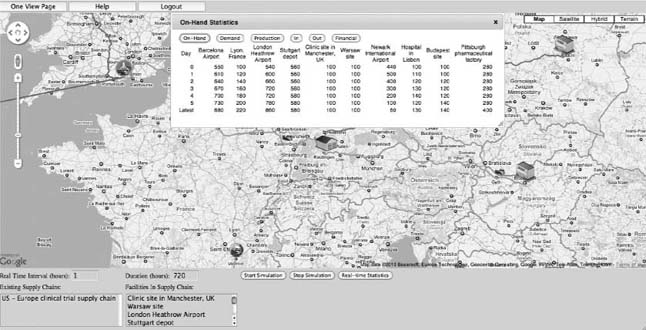
Once a supply chain is put into operation, the system could use simple data interfaces with the existing systems of the facilities and vehicles in the supply chain to collect data on a daily or even hourly basis and display the status of inventory at each facility. As shown in Exhibit 7.3, system users can click on any facility and get a data display showing current status of inventory at that facility.
Support for Collaborative Operations and Decision Making
As the users of this system (this MMO sandbox) collaborate to design effective supply chains to respond to changing conditions, the system could constantly keep track of the operating characteristics of the supply chains that were created and the users could select those designs that provided the best results. And then once that supply chain was in operation, the system itself would collect live data feeds from the actual facilities and parties in the supply chain and display real time status of ongoing operations. This would be a powerful inter-company collaboration platform. This platform combines the practices of collaborative planning, forecasting, and replenishment (CPFR) and sales and operations planning (S&OP) as described in Chapter 6. It would be a serious game whose object is for its players to monitor and manage their supply chains so as to best respond to changing business conditions.
As demand for products fluctuates, and as operating costs for factories, warehouses, and transportation modes change, companies and their supply chain partners could constantly test out different ways to meet demand while minimizing cost. If inventory planners and supply chain operators could literally draw supply chain configurations on an electronic map display and then simulate those configurations over some time period, they would quickly learn what combinations produce the best results. They would become immersed and completely involved.
Simple Data Connections Collect Continuous Data from Facilities and Vehicles
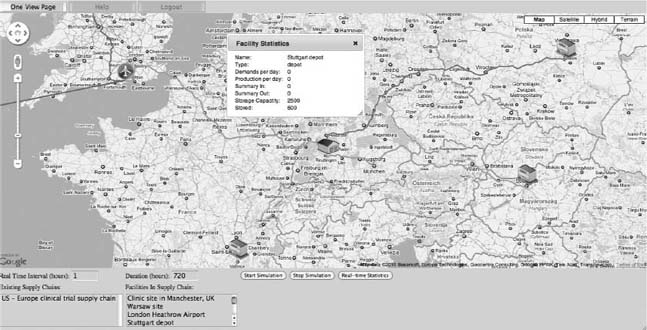
People would develop very accurate intuition about how best to respond to changing business conditions. They would be able to constantly adjust their supply chains to maintain the highest service levels at the lowest costs. And companies using this supply chain system would continuously learn and adjust their supply chains while incurring less risk and less cost than companies that learned only in the real world by trial and error alone.
(Readers can use a version of this system at www.MichaelHugos.com by clicking on the link for “SCM Globe”. Companies wanting to explore using this system in their business can contact me about a more full-featured version to collaborate with their customers and suppliers.)
Supply Chains and Simple Data Connections
In all supply chains there are five drivers: production, inventory, location, transportation, and information. And the goal is to manage them so as to “Increase throughput while simultaneously reducing inventory and operating expense” as Eliyahu Goldratt so eloquently put it in his book The Goal.
Accomplishing this goal requires constant adjusting of the first four drivers to get the right balance of efficiency and responsiveness as the world unfolds. The key to achieving this balance is to have timely and accurate information and act effectively based on what it tells you. Information is the central leverage point for running any good supply chain.
Continuous Balancing between Efficiency and Responsiveness
One ever-present challenge in running an efficient supply chain is to cope with the effects of a dynamic called “The Bullwhip Effect,” a illustrated in Exhibit 7.4. Small changes in demand for products at the front of a supply chain create increasing distortion in the perceived demand for those products as you move toward the back of the supply chain.
Demand forecasting and the related S&OP tasks are the basis for running efficient supply chains, but in high change and unpredictable times like these, it's hard to do these tasks well. It takes good data and requires people in different companies to collaborate to do these tasks well, because a supply chain isn't just one company, it's a network of companies. This is illustrated in Exhibit 7.4.
Efficient supply chains reduce inventory and operating expense, but it takes responsive supply chains to increase throughput. And to increase throughput, supply chains have to provide what customers want. Throughput is also known as sales, so to increase sales (as well as profits) companies need to do more than just offer basic products at low prices. They need to respond to opportunities to wrap their basic products in blankets of value-added services (from e-business services to customer service) that are tailored to fit customers' evolving needs and desires. This is illustrated in Exhibit 7.5.
Good Supply Chain Strategy Is Based on Timely and Accurate Data
Because accurate and timely information is the central supply chain driver, good strategy starts with improving the accuracy and flow of data between companies working in a supply chain. All other strategic decisions and tactical actions depend on this. Effective strategies support creation of a “virtuous cycle” of continuous improvement, and good information is what makes that possible. Exhibit 7.6 shows how this virtuous cycle comes into being.
Most supply chains still do not have the accurate and timely data they need because they lack effective electronic data connections between companies. Electronic data interchange (EDI) systems are used by many large companies, but those systems are expensive and complicated. In some instances EDI has been replaced by extensible markup language (XML), yet those systems too are expensive and complicated.
Supply Chains Need to Respond to Continuous Fluctuations in Supply and Demand
Efficient Supply Chain
“Bullwhip Effect”
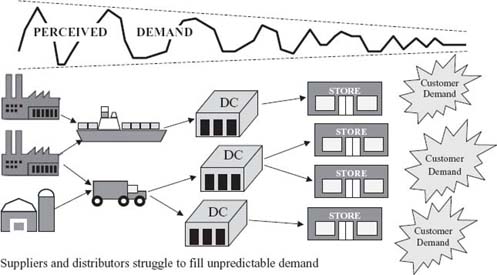
Wrap Products with Tailored Blanket of Value-Added Services
Responsive Supply Chain
Increase product value and sales margins by wrapping products with a blanket of value-added services tailored to respond to specific customer needs and desires
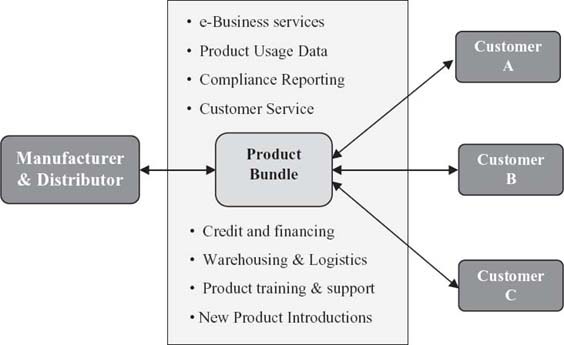
In most supply chains the big Tier 1 brand-name companies are a minority, most companies are the smaller Tier 2, Tier 3, and so on companies, and they still use e-mail, faxes, and spreadsheets to move data between each other because they can't afford the complex and expensive systems used by Tier 1 companies. Until simple data-connection solutions are found, it will continue to be a problem to get timely and accurate information to manage supply chains (Gatepoint Research, Pulse Report Survey of Critical Supply Chain Trends: Summary Results, December 2009).
As data flows through these simple data connections it is then possible to do comparisons between different data sets and display continuously updated score cards that show performance of the supply chain overall and performance of each of the companies in that supply chain. A sample score card is shown in Exhibit 7.7. When everybody can see those score cards every day, they have the information they need to start and maintain a virtuous cycle of continuous improvement.
Virtuous Cycle Starts with Electronic Data Connections for All Parties
Evolving Supply Chain Strategy
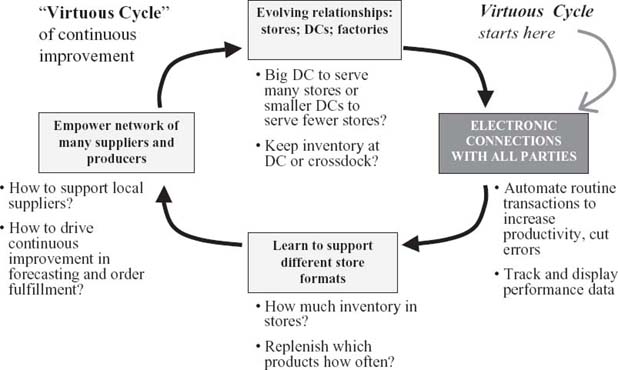
This visibility created by universal data connections is the basis for effective supply chain management. These simple solutions and the systems they support are better than the present complex solutions because simple systems using good data a deliver better results than complex systems using bad data (there is an old saying in the computer world that goes like this, “garbage in, garbage out”).
Scorecard for Supply Chain Performance Provides Real-time Transparency
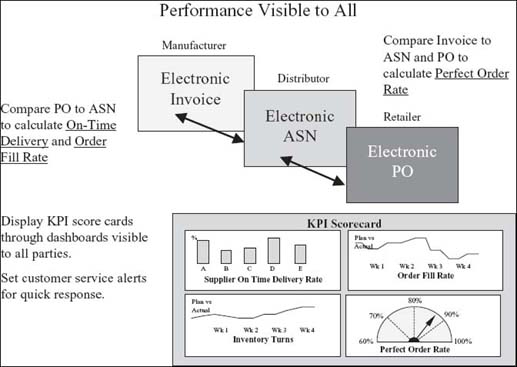
A huge opportunity exists right now in global and local supply chains to electronically connect all companies from the largest to the smallest. And since simple solutions are the only ones that will work for everybody, they are the only ones that will work at all.
I built a simple data connection and scorecard system like this to connect more than 80 smaller companies in a national distribution cooperative with the much larger companies of their customers and manufacturers (see Chapter 9, “Conceptual Design for E-Business Systems Infrastructure”). It connects the different ERP systems of these companies, supports billions of dollars in commerce, and enables other applications such as business intelligence, business process management (BPM) and S&OP.
EXECUTIVE INSIGHT

Many strategic experiments in organizations are enabled by information technology (IT) and organizations that employ a mindful approach to experimentation and their use of IT are likely to be in a better position to achieve the benefits they are looking for. Associate professor C. Ranganathan at the University of Illinois at Chicago believes that mindfulness at the individual level is characterized by openness to novelty, alertness to distinction, sensitivity to different contexts, awareness of multiple perspectives, and an orientation to the present.
The idea of mindfulness has been extended to organizations, and research finds that mindfulness enhances an organization's innovative ability as it fosters exploring a problem from multiple perspectives and focusing on business processes and ways to improve those processes. Organizational mindfulness is also associated with adaptive management of stakeholder expectations as unexpected events occur. Mindful organizations practice continuous learning where organizational actions are based on what they have learned about themselves and their environment. Mindful organizations apply insights from their learning to their strategic IT experimentation.
Singapore-based YCH Group is one such mindful organization. They are a leading logistics and supply chain management company which provides integrated, end-to-end supply chain solutions to some of the world's largest companies including Dell, Motorola, LG, Pfizer, and Unilever. With more than 500 million square-feet of warehouse space, YCH Group handles more than $50 million worth of goods for its multinational corporation (MNC) customers.
YCH Group's intention is to help improve the business of their customers so that as their customers do well, YCH Group will also do well. To this end, YCH group engaged in strategic IT experimentation to integrate three supply chain flows in a single, integrated process. Those three flows are: 1) physical flows of inventory from one point to another; 2) information flow of data about the inventory; and 3) financial flow of ownership and related documents about the inventory.
YCH group pioneered using RFID for liquid and other controlled products in a bonded warehouse environment. A bonded warehouse is a licensed area that is used to store controlled items such as alcohol or cigarettes for re-export or local consumption. YCH group not only had to strictly adhere to the customs guidelines, but also ensure integrity and security of data at any point of time. They developed a unique “One-Touch” strategy using RFID technology. The One-Touch strategy uses two key components. The first component is a software that ensures data is clean and error-free at the point of collection and that data integrity is maintained seamlessly thereafter (hence, “one-touch”). And the second component is technology that ensures that the data filtered at the source is accurate. Chief Operating Officer James Loo explains further, “We were able to capture right data at the source, and manage this data through its lifecycle. One-Touch ensures that despite multiple modifications, enhancements, and process flows, the core set of data is kept secure and intact. Data remains accurate and available for appropriate users in the value chain.”
Exhibit 7.8 depicts a typical process flow in a YCH bonded warehouse. When bonded goods arrive at the main distribution center, each pallet gets a radio frequency identification (RFID) tag. The tag contains product information as well as data on arrival time and designated storage location. Handheld readers are used to record and retrieve information from these tags. Forklift operators pick up the pallet and make their way to the designated storage location. The reader emits a light when this location is reached so that the operator knows the exact spot for storage. On receiving orders from customers, the RFID reader is used to help staff locate the goods. This also makes it easier for customs officials to conduct spot checks; otherwise they have to walk all over the warehouse and move up the racks to find the pallet they are looking for.
The forklift driver then removes the goods from the storage area into the outbound (or staging) area. While the goods are en-route to the staging area, the RFID reader will send a signal to prompt the computer system to start printing the relevant documentation. By the time the forklift arrives with the goods, all relevant paperwork and labels are ready, making it easier to load the shipment onto the trucks with minimal delay. Before RFID was implemented, staff had to wait for the goods to arrive at the outbound area before preparing the dispatch documentation.
Through RFID, YCH group also gained end-to-end visibility of stocks as they pass through the supply chain. YCH can now ensure that the pallets and cartons comply with the picking and transfer order requirements. YCH can also track goods in the storage area as well as their movement throughout the supply chain. YCH's stock-taking and verification have become error-free and easier. Each RFID gantry has an LED panel so that the forklift driver knows that the goods have been captured by the reader and recorded in the warehouse management system. With this, YCH is able to offer visibility of the cargo for customs purposes and to facilitate planning throughout the distribution process. Custom clearance application forms and recommendations for replenishment are also automatically generated.
Process Flow in YCH-bonded Warehouses

Adapted from a paper by Teo, T.S.H., Srivastava, S.C., Ranganathan C., and Loo, J.W.K. “A Framework for Stakeholder Oriented Mindfulness: Case of RFID Implementation at YCH Group, Singapore”, in European Journal of Information Systems, 2010.
Social Media and Real-Time Feedback
Facebook is defining a genre of software that will become as generic and widespread as the spreadsheet and word processing. And that means Facebook is probably not the last word in this genre. Maybe it's only an early incarnation. For example, the first popular spreadsheet was called Visicalc; it introduced the world to this genre of application. Then Visicalc was succeeded by Lotus 1-2-3, and then Lotus was surpassed by the current market leader, Excel.
Perhaps MySpace was the first popular incarnation of this new genre. Then MySpace was succeeded by Facebook. And maybe there is another contender now in the works that will surpass Facebook. Things happen fast these days. Software vendors are introducing systems that are cloud-based, software-as-a-service (SaaS) applications that have simple user interfaces much like Facebook but also come with additional features businesses need that Facebook and other current social media applications lack—like better security, better administrative control, and better user analytics (applications like Jive and Yammer are examples).
There may be a bigger and more compelling case for businesses to build and spend time maintaining their social networks than there is for individuals to do this. If maintaining social media sites was part of a paying job and if it was shown to generate measurable benefits for companies that did it well, there would be lots of demand for this activity.
Social media and related SaaS applications provide excellent real-time communication and collaboration platforms for companies that do business together. They provide real-time feedback that companies can use to continually communicate with their supply chain partners and adjust their daily operations to fit real-world circumstances.
Business-oriented social media can be used for everything from providing customer service and technical support to managing supply chains and executing joint marketing and sales campaigns. Business-oriented social media could well become, as Steve Jobs, CEO of Apple once put it, “the next insanely great new thing”. It could enable companies to monitor and manage their business ecosystems in real time as our global economy continues to evolve.
If companies defined their target audience and then crafted appropriate messages, they could practically read their customers' minds. They would always know what customers wanted and could deliver the right products at the right prices at the right time.
How is this possible? It's possible if companies that do business together “friended” each other on Facebook or other similar types of social media platforms. For instance, if companies linked their company Facebook pages with those of their repeat customers and their main suppliers, they would have a powerful real-time communication platform in place to work with all the companies in their extended supply chain.
Once they had this real-time communication platform in place, the next thing companies could do is use it to “communicate with” instead of just “talk at” their customers and suppliers. Meaningful communication starts by asking relevant questions. Instead of a company telling its customers what it has for sale, it could ask customers what they would like to see the company sell. Companies could ask customers what their problems are and find ways they might be able to help. Companies could suggest ideas for products and services and see how customers reacted.
Social media is a two-way medium. The power of social media is that it puts out messages and also returns messages and does so in real time. And that capability is what creates the feedback loops that enable companies to understand what their customers want so they can stay close to them over time as the world changes. This is how companies can have the right product at the right price at the right place and right time.
Social media used this way connects companies with their best customers and their most important suppliers. It makes possible the two-way communication that generates the feedback they need to sense and respond to constantly evolving situations and desires of customers and suppliers.
Chapter Summary
Collaboration and coordination are the keys to effective supply chain performance and profitability in this century. In the slower moving and more predictable economy of the last century, most companies placed their emphasis on the use of centralized command and control to achieve performance and profitability goals, but command and control techniques do not perform well in fast-paced and unpredictable markets like those we live with now. Practices from CPFR can be used to improve collaboration and the S&OP process provides ways to improve coordination within and between companies.
A category of online computer games known as MMOs provides technology and innovative ideas for creating the kind of real-time simulation and monitoring systems that companies can use to work together in global and regional supply chains. Because profit margins are thin and supply chains are complex it is increasingly risky for supply chain practitioners to learn by trial and error alone; they are prone to making expensive mistakes that can threaten a company's viability. Using MMOs, people can take advantage of real-time reporting of actual supply chain status (BI); they can try out plans of action to see the probable result (simulation modeling); and they can then select the best plan and coordinate with each other to carry out the plan successfully (BPM).
The larger companies that have been in existence for a while often use EDI or XML to make electronic connections and send supply chain data to each other. These technologies work well for those that can afford them, but they are expensive and complicated and smaller and newer companies often do not have the capability or desire to work with those technologies. They use simple methods such as e-mail and faxes to send data to their supply chain partners, which causes delays in data transmission and is the source of many errors in the data.
The spread of cloud computing and wireless broadband Internet connections makes it possible to offer an inexpensive and easy-to-use data connection technology. Such a system will not be able to do everything that more complex EDI and XML systems can do, but it will still deliver better results. This is because simple systems that deliver accurate data in a timely manner will outperform complex systems hampered by data that is not timely or accurate.
The use of social media to assist in the coordination of business activities is only starting to be explored. There is an emerging class of software that is patterned on social media but which also has additional features such as better data security and better administrative monitoring and control features. This kind of social media software used in business can provide a real-time communication capability that companies can use to stay close to the changing desires of their customers and the changing trends in their markets.
